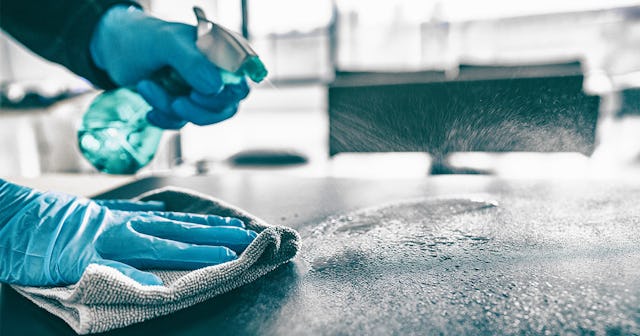CDC: Disinfecting Surfaces Is 'Typically Not Necessary' To Reduce COVID Risk

The CDC’s new guidance indicates that obsessive disinfecting isn’t necessary unless someone is sick or has known exposure to COVID-19
If you still have lingering nightmares from the early days of the coronavirus pandemic when we all thought taking a Lysol wipe to our food and disinfecting every surface in our homes was a necessary part of the fight against COVID-19 transmission, you can officially breathe a bit easier. The Centers for Disease Control and Prevention (CDC) has confirmed that “the risk of surface transmission is low” when it comes to the virus, and if you aren’t around anyone that is confirmed positive or suspected to be positive, your regular old cleaning routine should certainly suffice.
As reported by CNN, CDC officials confirmed that, generally speaking, surface transmission is low, with Vincent Hill, Chief of the Waterborne Disease Prevention Branch calling it “secondary to the primary routes of virus transmission through direct contact droplets and aerosols.”
Of course, that doesn’t mean you should start licking the subway pole on your daily commute, but it does seem that most household surfaces are perfectly fine with your regular cleaning protocols. Hill noted that the risk of surface transmission is “elevated” with hard, indoor surfaces, but that the virus dies “rapidly” on more porous surfaces and for surfaces outdoors or in direct sunlight, since the sun’s rays can help destroy the molecules that can make you sick.
Still, surface transmission seems to be highest within the first 24 hours of being infected — when most people are likely unaware that they have COVID. In households in which one person was confirmed positive with the virus, CDC testing showed that cleaning and disinfecting surfaces was helpful in preventing others in the household from catching it.
If you are unsure whether or not you or someone in your household has been exposed to COVID, Hill notes that it’s still worth disinfecting high-touch household spots, such as doorknobs, light switches, and kitchen and bathroom surfaces. But disinfecting measures shouldn’t replace other proven safety measures, such as keeping distance from others outside your household, wearing masks, and frequent hand washing.
“In most situations, cleaning surfaces using soap or detergent, and not disinfecting, is enough to reduce the already low risk of virus transmission through surfaces,” Hill said. “Disinfecting surfaces is typically not necessary, unless a sick person or someone positive for COVID-19 has been in the home within the last 24 hours.”
“Putting on a show” — or as Hill put it, “hygiene theater” — “may be used to give people a sense of security that they are being protected from the virus, but this may be a false sense of security, if other prevention measures like wearing masks, physical distancing, and hand hygiene are not being consistently performed. It also could make people feel less need to engage in these other important prevention measures,” he said.
Also, it’s worth pointing out that you should only be using your cleaning products of choice in the correct manner — spraying yourself with cleaning products not meant for the body is potentially dangerous (and also useless). “Public inquiries indicate that some people may purposely drink, inhale, or spray their skin with disinfectants, without understanding that use of disinfectants in this way can cause serious harm to their bodies,” said Hill.
The TL:DR is: don’t mix bleach and ammonia, don’t use household cleaners on your skin, and don’t ingest household cleaners. And make sure everyone in your house is following suit.